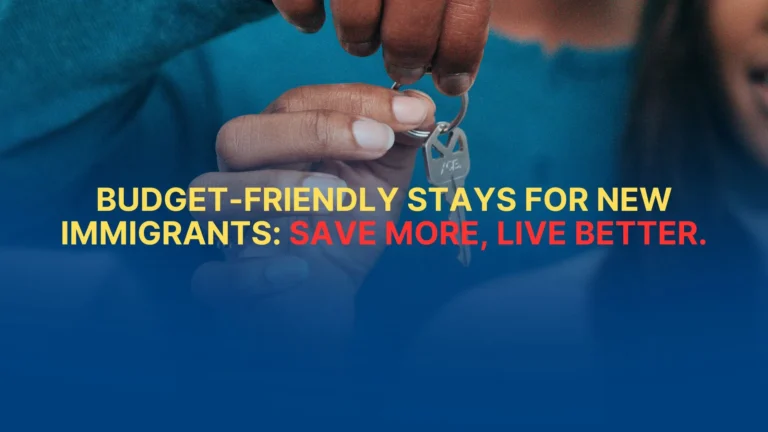Top Budget-Friendly Temporary Housing Options for Immigrants in The USA
Starting a new life in the United States is exciting, but it also comes with its fair share of challenges. One of the first hurdles many immigrants face is figuring out where to live without draining their savings. Think about it, after paying for flights, visas, and maybe even recruitment or relocation services, the last thing you want is to blow thousands of dollars on rent in your very first month.
That is why temporary housing becomes a lifeline. It is like a soft landing pad in a completely new environment. It buys you time to explore, adjust, and make long-term decisions without the pressure of signing a lease you may later regret. Whether you are moving to the U.S. for work, study, or to reunite with family, having access to budget-friendly housing options means you can focus on settling in rather than worrying about where you’ll sleep tomorrow.
But here is the catch: the U.S. housing market isn’t uniform. Prices vary wildly depending on the city, state, and even neighborhood. For example, a small studio in New York City can cost the same as a two-bedroom apartment in Houston. Without proper guidance, it is easy to overspend, or worse, fall victim to rental scams. That’s why doing your homework ahead of time is crucial.
In this guide, we’ll explore practical and affordable housing solutions for immigrants, ranging from extended stay hotels and shared rentals to nonprofit programs and community networks. We’ll dive deep into how to evaluate neighborhoods, what digital platforms to trust, and even insider tips like negotiating monthly rates. Think of this as your personal roadmap, helping you cut through the noise and find housing that is safe, affordable, and convenient.
By the end of this page, you will not only know the best temporary housing options in the USA but also how to save money while avoiding common mistakes. So, whether you are a first-time immigrant landing at JFK Airport or moving stateside for career opportunities, you will have a game plan for securing a place to stay without breaking the bank.
Why Affordable Temporary Housing Matters for Immigrants
For most immigrants, the first few weeks in the United States can feel like standing at the edge of a giant puzzle; you see all the pieces scattered around (work, documents, schools, transportation), but you don’t yet know how they fit together. And right at the centre of that puzzle lies one critical piece: housing.
Affordable temporary housing isn’t just about having a roof over your head; it’s about creating stability during an unstable phase of life. Think of it like the anchor that holds a ship steady while the captain decides which direction to sail. Without that anchor, everything else, like job hunting, building connections, and enrolling kids in schools, becomes harder.
Relieving Financial Pressure
Let’s be honest: arriving in the U.S. is expensive. Flights, visa fees, luggage, transportation from the airport — it all adds up quickly. If you then land in a city where rent swallows half your savings in the first month, you’re starting your American journey with financial stress. Affordable short-term housing gives immigrants breathing space. It means more money for essentials like food, clothing, transportation, and even emergency medical costs.
Providing Flexibility
Temporary housing gives newcomers time to explore before committing. Imagine signing a 12-month lease in a neighbourhood you have never lived in, only to realise the commute is two hours each way, or the area doesn’t feel safe. Budget-friendly short-term rentals, hostels, and extended-stay hotels allow immigrants to “test-drive” different areas without locking themselves into a bad deal.
Supporting Mental and Emotional Well-being
Moving to a new country is exciting, but it’s also overwhelming. Uncertainty about where you’ll live can add unnecessary stress. Having a stable, affordable place to call home, even if just for a few months, provides peace of mind. It helps immigrants focus on building their future instead of worrying about tonight’s shelter. In a way, affordable housing becomes the psychological cushion that softens the landing in a foreign land.
Creating Networking Opportunities
Temporary housing often puts immigrants in shared environments: room rentals, community housing programs, or shared apartments. While it might seem like a compromise, this is where many newcomers find valuable connections. Roommates or fellow tenants can introduce you to job opportunities, explain how public transit works, or even recommend affordable grocery stores. In immigrant communities, these networks are priceless.
Reducing the Risk of Debt
Without affordable housing, many immigrants are forced to borrow heavily or rely on credit cards to cover initial costs. High-interest debt can trap newcomers in financial struggles for years. Budget-friendly housing options prevent this spiral, giving immigrants the chance to save money instead of sinking into debt right after arrival.
A Stepping Stone to Permanent Housing
Finally, temporary housing acts as a bridge. It’s not the final destination, but it gets you from point A (arrival) to point B (a long-term, permanent home). Affordable short-term options allow immigrants to gather documents like proof of income, credit history, and references — requirements that most U.S. landlords demand before signing a lease.
Affordable Temporary Housing Options for Immigrants in the USA
When you are new in the U.S., finding affordable shelter can feel like trying to catch a moving train; you need to grab the right option quickly before it passes you by. Luckily, there are several temporary housing options for immigrants in the USA that fit different budgets and lifestyles. Let’s dive deep into each one.
Extended Stay Hotels
Think of extended stay hotels as the “middle ground” between traditional hotels and renting an apartment. They are designed for people who need to stay weeks or months, and many come with kitchenettes, laundry facilities, free Wi-Fi, and sometimes even breakfast.
Extended stay hotels can be a lifesaver for immigrants who arrive without a credit history or a rental background. Since most don’t require long-term leases or security deposits, you can move in the same day and move out whenever you’re ready.
Pros and Cons of Extended Stay Hotels
-
Pros: Utilities included, no lease hassle, flexible check-in and check-out.
-
Cons: Daily rates add up, making them more expensive in the long run compared to shared housing.
Pro Tip: Look for discounted monthly rates. Many chains like Extended Stay America, InTown Suites, and Studio 6 offer 20–30% off for long bookings.
Shared Housing & Room Rentals
If you are looking for the most cost-effective option, shared housing and room rentals are hard to beat. Instead of paying for an entire apartment, you just rent a room and share the common spaces with others.
For new immigrants, this is not just about saving money, it’s also about building connections. Sharing a house with other immigrants or locals can help you quickly adapt, learn about the culture, and discover hidden job opportunities through word of mouth.
Websites and Apps to Find Shared Housing
-
SpareRoom – Tailored specifically for room rentals in the U.S.
-
Craigslist – Old but still gold; just watch out for scams.
-
PadSplit – Popular among immigrants for its vetted, affordable listings with flexible terms.
Why it Works: Renting a room can cost as low as $400–$700 a month in cities like Houston or Atlanta, far cheaper than studio apartments that may cost $1,200 or more.
Hostels and Low-Cost Guesthouses
When you hear “hostel,” you might think of backpacking college students. But in reality, hostels are an excellent option for immigrants who just need a cheap bed and safe place to stay for a few weeks.
Most hostels offer shared dorm rooms with bunk beds, communal kitchens, and common lounges where you can meet other people, many of whom may also be immigrants or travelers. Some even provide private rooms at slightly higher rates.
When Hostels Make Sense for Immigrants
-
You are single and traveling light.
-
You just need a few weeks before securing long-term housing.
-
You are looking for ultra-low daily rates (some start at $25–$40 per night).
Pro Tip: Use platforms like Hostelworld or Booking.com to compare rates and check reviews before booking.
Airbnb & Short-Term Rentals
Airbnb isn’t just for vacations, it’s a fantastic option for immigrants who want more privacy than a hostel but less commitment than an apartment lease. With Airbnb, you can rent a private room, a basement, or even a full apartment for a few weeks or months.
This flexibility is perfect for families who want a temporary but comfortable place with a kitchen and home-like amenities. Plus, unlike traditional rentals, Airbnb doesn’t require a credit score, which can be a huge barrier for newcomers.
Tips to Negotiate Better Rates
-
Message the host directly, many are open to monthly discounts.
-
Book longer stays; weekly or monthly rentals often unlock hidden discounts.
-
Travel off-season when demand is low and prices drop.
Why it Works: Airbnb offers flexibility and privacy, while still being cheaper than hotels for longer stays.
Religious and Community Housing Programs
Across the U.S., churches, mosques, temples, and immigrant support organizations often open their doors to newcomers. They provide temporary housing, sometimes free, and sometimes at a token fee.
For many immigrants, these programs are more than just shelter, they’re a safety net. Community housing often comes with additional support like job leads, language classes, and food assistance.
Churches, Mosques, and Nonprofit Housing
-
Churches may host newcomers in parish houses.
-
Mosques and Islamic centers often run housing for immigrant families.
-
Nonprofits like Catholic Charities and YMCA provide affordable transitional housing.
Pro Tip: Reach out to local immigrant centers upon arrival. Many maintain housing resource lists.
Government-Supported Housing Programs
Government-backed programs can be a valuable option, although eligibility varies by immigration status. Some states and cities offer temporary housing support through shelters, transitional apartments, or rental assistance programs.
These are usually geared toward refugees, asylum seekers, or low-income immigrants. For example, some local housing authorities run emergency rental assistance programs that cover part of the rent for temporary stays.
Eligibility and How to Apply
-
Check the U.S. Department of Housing and Urban Development (HUD) website for local resources.
-
Visit your city’s housing authority office.
-
Nonprofit legal aid groups often help immigrants apply for housing assistance.
Why it Works: While it takes paperwork and patience, government-supported housing can reduce costs drastically and buy immigrants time to stabilize financially.
10 Websites and Apps to Find Budget-Friendly Temporary Housing Options for Immigrants in The USA
Finding affordable temporary housing in the U.S. can be a daunting task, especially if you are new to the country. Thankfully, a number of digital platforms now make the search easier, safer, and more flexible. Below are ten of the best websites and apps that immigrants can use to find housing options that won’t drain their pockets.
1. Craigslist
Craigslist remains one of the most popular platforms for room rentals, shared apartments, and sublets. It allows immigrants to search based on city, neighborhood, and price range.
-
Pros: Wide variety of listings, often cheaper than formal rentals.
-
Cons: High scam risk; always meet landlords in person and avoid sending money before seeing the place.
-
Tip: Use Craigslist only in combination with safe practices—trust your instincts and avoid “too good to be true” deals.
2. Facebook Marketplace
Facebook Marketplace has become a go-to option for finding short-term rentals, room shares, and even furniture for new arrivals. Immigrants can connect directly with property owners without the need for agents.
-
Pros: Direct landlord-to-tenant contact, no agent fees.
-
Cons: Listings can be unverified, so double-check legitimacy.
-
Tip: Join local immigrant or housing groups on Facebook for exclusive deals.
3. PadSplit
PadSplit is designed specifically for affordable shared housing. It offers furnished rooms with utilities included, often at weekly or monthly rates.
-
Pros: Transparent pricing, flexible contracts, no need for credit history.
-
Cons: Shared spaces may lack privacy.
-
Tip: Great for single immigrants who need a safe, low-cost option.
4. SpareRoom
SpareRoom is one of the largest platforms for room rentals and flatshares in the U.S. It caters to immigrants and professionals looking for affordable housing.
-
Pros: Verified listings, roommate-matching features.
-
Cons: More popular in bigger cities, limited options in rural areas.
-
Tip: Use the “buddy up” feature to team up with other immigrants looking for rooms.
5. Airbnb
Airbnb isn’t just for tourists, it’s a valuable tool for immigrants seeking temporary housing. Many hosts offer long-term discounts for monthly stays.
-
Pros: Fully furnished, utilities included, safe booking system.
-
Cons: Can be more expensive than shared housing.
-
Tip: Negotiate directly with hosts for discounted monthly rates.
6. Zillow Rentals
Zillow is widely known for home sales, but it also has a rental section where immigrants can find apartments, condos, and houses for short-term leases.
-
Pros: Verified listings, professional interface.
-
Cons: Not always budget-friendly; more geared toward permanent rentals.
-
Tip: Use Zillow for longer-term temporary housing, especially if you plan to stay 6–12 months.
7. Sublet.com
Sublet.com specializes in short-term housing, making it perfect for immigrants who need a place to stay while adjusting to U.S. life.
-
Pros: Transparent sublet agreements, wide range of options.
-
Cons: Some listings require security deposits.
-
Tip: Best for families or individuals who need flexibility but still want stability.
8. Roomi
Roomi is an app built specifically for finding roommates and shared housing. All users are verified, which reduces the risk of scams.
-
Pros: Identity verification, built-in payment system.
-
Cons: Limited coverage outside major cities.
-
Tip: Great for young immigrants, students, or professionals who want a safe roommate search experience.
9. HotPads
HotPads, owned by Zillow, is another strong option for rentals and sublets. It provides detailed neighborhood data, including crime stats and school ratings.
-
Pros: Neighborhood insights, mobile-friendly interface.
-
Cons: More suitable for medium-term rentals than very short-term stays.
-
Tip: Use HotPads if safety and neighborhood quality are your top concerns.
10. Kijiji (U.S. & Canada)
While more popular in Canada, Kijiji also has listings in certain U.S. areas and is worth checking out for immigrants seeking low-cost temporary stays.
-
Pros: Low-cost listings, similar to Craigslist.
-
Cons: Limited U.S. availability.
-
Tip: Best used by immigrants moving between the U.S. and Canada.
Digital platforms have made temporary housing searches much easier for immigrants in the USA. From Craigslist and Facebook Marketplace for quick finds to PadSplit, SpareRoom, and Roomi for safe shared housing, these tools offer affordable solutions. The key is to choose wisely, verify listings, and leverage discounts for longer stays. With the right website or app, immigrants can save money and settle comfortably while planning their long-term future in America.
What Documents Are Required for Short-Term Rental?
When it comes to short-term rentals, whether it’s Airbnb, shared housing, or subletting an apartment, immigrants in the USA often wonder: “What paperwork do I need to get started?” The good news is that short-term rentals usually require less documentation than long-term leases. However, landlords and hosts still want to feel secure about who they’re renting to.
Here’s a breakdown of the most common documents you might need:
1. Valid Government-Issued Identification
The bare minimum for almost all rentals is a valid ID.
-
For immigrants, this could be your passport, national ID card, or visa stamp.
-
Some landlords may also accept consular identification cards issued by your country’s U.S. consulate.
-
Airbnb and other digital platforms often require you to upload a copy of your ID to verify your identity.
Think of your ID as your universal key—it proves you are who you say you are.
2. Proof of Income or Employment (Optional)
Not always required, but some short-term landlords like to see that you can afford the rent.
-
If you already have a job, a pay stub, employment letter, or job offer letter can help.
-
If you’re new and job-hunting, showing proof of funds in a bank statement is often enough.
It’s a bit like showing you have enough fuel before starting a long road trip, it reassures the landlord you won’t get stuck halfway.
3. Security Deposit or Payment Proof
Even if the paperwork is light, money talks. Most short-term rentals require:
-
First month’s rent upfront (or first week if it’s weekly rent).
-
A refundable security deposit (anywhere from $100 to $500+ depending on the property).
-
Proof of payment receipt (bank transfer, PayPal, or cash).
This isn’t technically a document, but it’s a crucial part of securing your stay.
4. Rental Agreement or Terms & Conditions
Even short stays usually come with some form of agreement.
-
On Airbnb or similar apps, you’ll digitally accept the terms and conditions before booking.
-
For private landlords, you may sign a short-term lease or even a simple written agreement outlining rent, duration, and rules.
Keep a copy of this, it protects both you and the landlord.
5. Immigration-Related Documents (Rare but Possible)
Most landlords don’t check immigration status for short-term rentals, but in rare cases (especially if you are renting through community programs or nonprofits), you might be asked for:
-
Visa documents (F1, H1B, etc.)
-
I-94 travel record (entry/exit record for the U.S.).
-
Proof of refugee/asylum status if applicable.
This is usually the exception, not the rule.
For most immigrants, the only must-have document for a short-term rental is a valid ID and upfront payment. Proof of income and rental agreements come into play depending on the platform or landlord. The simpler the stay (like a hostel or Airbnb), the fewer documents you’ll need.
Keep Everything Digital
Since many short-term rentals are fast-moving, it’s smart to keep scanned copies of your passport, visa, bank statement, and job documents on your phone or email. That way, if a landlord asks, you can share them instantly without delay.
Average Rent in The USA
When it comes to temporary housing, one of the first things immigrants want to know is: How much does rent cost in America on average? The answer depends on many factors—location, property type, and even the time of year. But knowing the average rent gives you a benchmark to avoid being overcharged.
National Average Rent
As of 2025, the average rent in the USA hovers around $1,300 to $1,600 per month for a one-bedroom apartment, while two-bedroom units cost about $1,800 to $2,100 per month on average. Keep in mind, these numbers are just averages. Major cities like New York or San Francisco can cost double, while smaller towns in Texas or the Midwest might be half that price.
Here’s a quick breakdown:
-
Studio apartments: $1,000 – $1,300 per month
-
One-bedroom apartments: $1,300 – $1,600 per month
-
Two-bedroom apartments: $1,800 – $2,100 per month
-
Shared housing/room rentals: $600 – $900 per month
City-to-City Differences
Think of the U.S. rental market as a buffet—what you pay depends on where you sit.
-
High-cost cities: New York City, San Francisco, Los Angeles – Expect $2,500+ for one-bedroom apartments.
-
Mid-range cities: Chicago, Philadelphia, Atlanta – Around $1,500 for one-bedroom apartments.
-
Affordable cities: Houston, Phoenix, Dallas – $1,000–$1,200 for one-bedroom apartments.
How This Impacts Immigrants
For new arrivals, these numbers can be intimidating. But here’s the good news: temporary housing options like extended stays, room rentals, and community programs often cost much less than national averages. For example, renting a shared room in Houston may only cost $500–$700 per month, half the price of a solo apartment.
Use Rent as a Budgeting Anchor
Immigrants can use the national average as a compass. If you’re quoted way above these numbers (without extras like furniture or utilities included), you might be overpaying. Conversely, deals much cheaper than these averages should raise red flags for scams.
Conclusion
Finding budget-friendly temporary housing for immigrants in the USA is more than just a hunt for a roof over your head, it’s the first steppingstone to building a stable, successful life in a new country. For many newcomers, the early weeks and months set the tone for how smoothly their transition goes. That’s why choosing the right housing option is not just about cost, it’s about security, community, and peace of mind.
Think of temporary housing as a launching pad. Just like a rocket needs a stable platform to take off, immigrants need an affordable and safe base while they search for jobs, enroll children in schools, or get familiar with the American system. Without it, expenses can spiral, stress levels rise, and settling down becomes far more difficult than it needs to be.
What this guide shows is that there’s no one-size-fits-all solution. A single professional may thrive in a hostel or shared rental, while a family might find comfort in an Airbnb or extended-stay hotel. Others may prefer the support of faith-based housing programs or the structured relief of government-assisted housing. The good news? The U.S. is filled with countless choices, you just need to know where to look, what questions to ask, and how to protect yourself from common pitfalls like scams or hidden fees.
Above all, remember that temporary housing is just that, temporary. It’s not your final destination but rather the bridge that connects your arrival to your long-term home. By budgeting wisely, leveraging community networks, and keeping flexibility in mind, you can turn this transitional period into a smooth, empowering experience rather than a stressful one.
So, whether you’re planning your move or already in the U.S. searching for options, take comfort in this: thousands of immigrants have stood exactly where you are now, and they’ve found affordable solutions that helped them move forward. With the right information, and a little determination, you will too.
Your journey in the United States begins with where you sleep tonight. Choose wisely, stay patient, and let your temporary home be the foundation for the permanent life you’re building.





